
Nuffield International 2019 Africa Agribusiness Tour
Ben Todhunter (New Zealand, 2006 Nuffield Scholar)

In May and June of this year, Nuffield International organized a tour through East Africa for past scholars and invited participants.
A tour overland through Kenya, Tanzania, Zambia, and Zimbabwe for 24 days was always going to be an ambitious and challenging undertaking. But what an opportunity! Having family history in Tanzania had always put East Africa on the travel list, and when the chance came up to visit on a Nuffield tour, I was in. The attraction of travelling with other like-minded people from around the world while learning about Africa and interacting with locals seemed like an opportunity too good to be true – especially if someone else organized it.
On 20th May 10 Kiwis, 1 Aussie, 2 Canadians and our guide Wayne Dredge met in Nairobi, with local contact Dr. Sarah Flowers. The team represented a wide range of expertise and interests including fishing, genetics, feedlot beef production, large scale dairy, forestry, hill country sheep and beef, fine wool, broad acre cropping, guided hunting, tropical dairy, transport and the oil industry.
Twenty-four days later we all departed Victoria Falls as firm friends having shared an amazing experience with some stories to tell, and retell.
Jim Geltch and Jean Lonie asked me to provide a bit of a summary of the trip in a couple of pages and I must say because of the sheer scale of what we observed and the country we covered I have been procrastinating at the daunting prospect of condensing all that down to a few pages of pithy points. It’s sort of like writing a Nuffield Scholar report in executive summary form. My apologies in advance because I think I might fail on the two-page limit.
But first the funeral. Wayne’s partner, Caroline, who was to travel with us had her father pass away as the trip started. We extended our sympathies as best as you can in the circumstances and missed her presence for the tour.
Wayne provided some very useful basic facts prior to our trip and I will do the same here as context:
| Kenya | Tanzania | Zambia | Zimbabwe | |
| Population (million) | 49.3 | 58 | 16.5 | 16.5 |
| Population (density: people/sqKM) | 78 | 47.5 | 17.2 | 33 |
| Population growth | 1.50% | 3% | 2.9% | 2% |
| 2050 population projection (million) | 97 | 137 | 42 | 29 |
| Average age | 18 | 17.7 | 16.8 | 19 |
| Agriculture (as % GDP) | 34.5 | 24.50% | 8.6% | 12% |
| GDP growth over last 4 years | 5.70% | 6.25% | 3.7% | 1.50% |
| 2018 GDP per capita (USD PPP) | 3461 | 3227 | 4216 | 3024 |
Sources: Wikipedia & World Bank
These countries have all got young populations and are going through the phase of population growth driven in part by improved longevity and reduced infant mortality. As female education and opportunity improves it is expected the rate of population growth will slow. However, with the demographic make- up of the population there is a long lag time before population growth slows.
This large pool of cheaper labour is starting to attract some interest for business as some Asian countries age and become more expensive. Mobile phone coverage is good, so Africa is potentially leapfrogging through some technology changes such as missing the fixed line era and developing mobile banking apps that work in their markets.
Kenya and Tanzania have been growing consistently and strongly, Zambia less so and Zimbabwe has had some growth but contracted last year and looks set to do the same again this year.
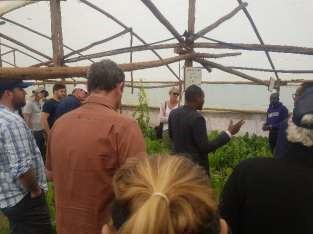
Our first place to stay was the Karen Blixen Coffee house in Nairobi. Blixen wrote “Out of Africa” and her story mirrors some of the stories of success and progress and decline that are intertwined with some African narratives. At one stage she wrote:
“Here at long last one is in a position not to give a damn for all conventions, here was a new kind of freedom which until then one had only found in dreams”
The freedom to do as one pleased and be free of regulation and bureaucracy, especially in the labour and land management areas, was cited by many people we visited as one of the advantages of living in Africa. Sadly for Blixen her first husband had a bit too much freedom and she reportedly contacted syphilis from him which she claimed affected her health for the rest of her life.
Our accommodation was generally in gated lodges and to a high standard. It did remove us from some of the hurly burly of African life but it was maybe designed to restrict some of our aforementioned freedoms and to keep us safe.
Farming is not viewed as a great career in Kenya but land ownership is a sign of success. An aspiration to build a house on one’s own plot was regularly mentioned. Simplistically land is owned by larger farmers and corporates and by small holders. The small holders may be subsistence farmers but also may have other jobs and use the land to provide food for the family and additional income. Some of the small holders in higher rainfall areas run incredibly productive diverse systems, with pigs, chickens, vanilla, bananas, avocados and timber trees.
One of the opportunities to improve the lot for communities in East Africa is to improve the lot of the smallholder. Many NGO’s focus on this group but where we saw real opportunity and progress was with commercial enterprises providing and scaling commercial solutions for these smaller farmers.
A useful example of this is Margaret Munene, the owner of Palmhouse Dairies. She described her journey building a dairy business which was working with 500 mainly women suppliers with 3-4 cows to provide a healthy product to consumers and provide profit to suppliers. Some of her key challenges (which are not just limited to Kenya) are:
- Farmers need credit, so Palmhouse provided and took off the milk cheque.
- High costs of inputs e.g. feed is purchased for the cows and is expensive.
- A resistance to the cost of vet care for the cows so vets are used and cost is taken from the milk cheque.
- Infrastructure for collection. Collection points, measurement, QA, poor roading. Interestingly Kenya decentralizing and going to a federal system has improved infrastructure.
- Seasonality of production.
- Inadequate farm R & D, so Palmhouse is providing Tech transfer to suppling farmers.
These economies are often cash based and Palmhouse endeavoured to pay into bank accounts which reduced the opportunity for corruption but also had the advantage of giving the women more control over their finances. Margaret was then able to set up the Palmhouse Foundation that has helped to educate over 1000 children from poorer areas.
Natural Extracts Industries in Moshi, Tanzania was another business solving the problems of traceability and QA with small holders by using mobile solutions. Now with 4500 farmers supplying vanilla one interesting strategy had been to train “champion” farmers to help with distribution, scaling, R & D, and tech transfer.
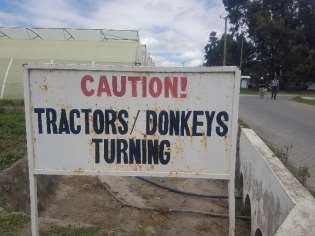
One of the major challenges of dealing with smallholders is ‘side selling’. For many storable products there are a range of traders with dubious reputations offering cash at farm gate. This is not just an African issue.
Where support for small holders did not appear to be commercially driven it looked to me to be a recipe for locking these people into subsistence farming.
We had a look at Dudutech, a smart Integrated Pest Management company, delivering biological pest control solutions into the East African market, demonstrating what can be achieved with good execution. The visit also highlighted some of the local talent available for these businesses and some of the cultural biases evident. Where we had a local and foreign executive presenting to us the foreign one often dominated the conversation but did not necessarily dominate in the knowledge or skills area.
Dudutech was one of the few companies where environmental concerns were explicitly mentioned. Environmental issues will affect Africa but the trip highlighted that provision for the environment generally comes after economic growth and food provision.
Another encounter with game in Zimbabwe led to ‘NDE No1’. There may be different interpretations of the events that lead up to this Near-Death Experience, but in the nature of history writing, he who holds the pen has the say. Rhinos are so valuable for poaching that they are generally under 24- hour armed guard. Visiting a game preserve with four Rhinos, we were allowed to go to the fence of the enclosure they were gathered in at night. Standing at the fence was an incredible experience as Rhinos came up to check out the visitors and some of us could scratch their horns with only a fence that looked like matchsticks to a rhino between us.
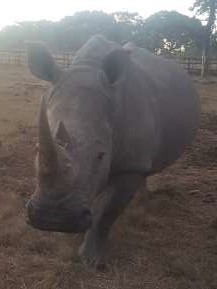
One of our team, who shall remain nameless, chose to get a different look out to the side at the open entrance to the enclosure. This appeared to attract the male rhino who came and walked out of the gate past said member. Having a wild Rhino go past within a meter of you is an unforgettable moment. What also is unforgettable is watching the rest of the team scatter as the Rhino proceeded to do two charges. Luckily for us, and for Derek, air – and not much at that – separated the Rhino from contact. Pulling his hamstring as he outran one of nature’s fastest and more dangerous animals will be a story to tell and retell.
As we drove the roads of Kenya and Tanzania, we saw herders grazing their flocks of sheep or goats or herds of cows. Many of the animals looked in poor condition and the land appeared overgrazed. A historical herding culture and their displacement from traditional lands is leading to poor land management and a complex issue that will be difficult to solve. Good grazing management has the potential to regenerate soils throughout Africa but dealing with the cultural and property right issues to enable this will not be easy. Looking at some of the cropping soils also outlined some of the challenges. Continued mechanical cultivation led to reduced organic matter and poorer structured soils. Using No Till and cover crops improved this but finding a way to incorporate animals into the rotations seemed an opportunity to further improve these soils.
Driving the Tanzanian roads it’s impossible to avoid the traffic police. Virtually every town had traffic officers on the outskirts which did not appear to be serving any safety purpose. Foreign vans seemed to be fair game and may have provided more opportunity for revenue.
We got a bit bored with this game and started getting our bigger members to ‘listen in’ on the judicial discussions. Our attempts at intimidation probably made no difference but made us feel a bit better and more in control.
One of the issues in Tanzania appeared to be the acceptance that the government could have a large say in your lives such as the overzealous policing. This carried over into the potential to interfere in markets for agricultural products and was one of the bigger risks for investment in this country.
Driving the roads, we are also confronted with the sheer logistics challenges present. To export avocados from Mkushi in Zambia requires 4-day trips to Mombasa in Kenya or Cape Town in South Africa. A 12-hour trip crossing the Tanzanian border into Zambia along parts of the northern Zambian arterial road in a confined van with a driver not used to our personal hygiene practices was a challenge for much of the group. The road a main linkage to the mines in the Congo and Western Zambia was a mess and was chocka with fuel tankers servicing these mines.
The Mombasa Nairobi Highway is a vital arterial link from the coast for Kenya, and for the land- locked countries of Burundi, Eastern DR Congo, Uganda, South Sudan and Rwanda and carries more than 50% of goods traded in the East African Community. Given the scale of trucking and traffic the road is grossly inadequate and dangerous. On our way to Tanzania we were halted for a five- truck pile up. A toll expressway is due for construction to start to replace the road cutting travel times by more than half.
China has invested in infrastructure throughout Africa including the Nairobi-Mombasa Railway. There are criticisms of this investment and in some places, it is highly visible and may not be delivering the purported benefits. Improving infrastructure and access to global markets is important for African development. To my mind if you wanted to invest in Africa, you would want to do it very carefully, you would want to deeply understand the local laws and cultures, and you would want strong relationships with the people you were dealing with on the ground. The risks for that investment are high. I don’t see that Chinese investment in Africa is any different and it looks to me that some of this investment will benefit African countries more than Chinese companies.
The World Agroforestry center in Nairobi had some gems of research for industry such as speeding up and reducing the cost of soil testing with hyperspectral imaging, new crops for semi-arid lands and crop selection decision support tools. It however did have the appearance of an institution a bit removed from industry.
African farmers do not appear to be immune from the economics of agricultural product cycles. We saw much investment in Avocado and macadamia production, which would be a cautionary tale for those investing in these products elsewhere – unless you have a supply window advantage. Macadamias present a challenge as a storable product that makes theft a viable proposition. Security costs and slippage were cited as reasons not to plant maca’s
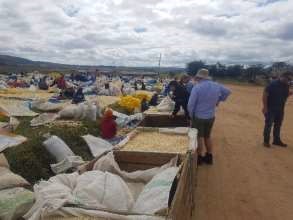
Labour costs are another notable difference to our production systems. We have invested heavily to systematize and reduce labour costs. It was foreign then to see areas where labour is still used in processes that could be mechanized. Given the costs of labour at $1USD to $3USD/day this is entirely rational. Large areas, of mainly women, de-husking and sorting maize seed by hand was a common sight on Maize seed farms. I felt uncomfortable when taking photos of these women and they often asked for money.
The African women are to be admired. Not just for their carriage and physical appearance, but mainly for their persistence and diligence at work. It is not uncommon to see one walking with a child carried front and back and a load on head and in hand. Pulling up at a Zambian petrol station and having drunk men on one side and women trading products on the other was an extreme example of the working roles of the different sexes.
Social License is increasingly used as a term in New Zealand in relation to farmers ability to carry out their work with the support of the whole community. In some ways this appeared to be magnified in Africa. Those farmers who were embedded as part of the community, tended to have less problems whether that be with theft or getting things done quicker and generally had less trouble. Being part of the community sometimes included providing healthcare and education.
One of the benefits of travelling on a tour like this is the strength of the Nuffield brand and network. The access to top farms and the willingness for capable people to give up their time to show us their enterprises and to come and talk to us provided so much depth to our experience. As an example, in Dodoma we dined with the ex-president of Tanzania. Having local people travel with us providing commentary and insight throughout the journey helped with our understanding of the history, geography and cultures of the countries we visited. Enjoying many sundowners with groups of locals after a day travelling and visiting provided rich memories for the participants. Special thanks to Ellie Stanley, Sarah Flowers, and Rob Fisher who travelled with us for parts of the trip and were very generous with their time and knowledge.
Kafue fisheries near Lusaka, Zambia was a fascinating visit. Run by the character Speedy Holden the integrated pig and fish farm is circular in nature.
Pigs are farmed on pond banks, effluent from the pigs is washed into fishponds of Tilapia fish. The effluent promotes algae growth which the fish feed on and then the water is drained out through reed wetlands to reenter the river in as good a state as it leaves it. The feed conversion efficiency for the fish didn’t fully support some of the claims but it was an impressive operation. Speedy provided an interesting example of an unintended consequence. He gives thanks to Bill Gates, on a daily basis, claiming the Gates foundation provision of insecticide treated mosquito nets provides a cheap fishing net resource which pollutes waterways and reduces insect populations in rivers and hence wild fish stocks, thus reducing Speedy’s competition.
Land ownership throughout Southern Africa is a highly charged topic, and Speedy made the comment that “there will be no major portions of white land ownership in Africa in 20 years.” Given population pressures and political realities it appears the ability to hold onto larger, single family land holdings in the future will be difficult. Better to invest in highly productive smaller areas or further down the value chain.
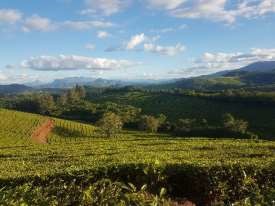
“Near Death Experience 2.” Travelling out to view wildlife from Victoria Falls one morning a few of our team got closer than they wanted too. A large Elephant came out of the bush and their driver swerved to avoid it. They just missed the ellie, but went off the road and rolled the vehicle. Fortunately, again they were all well and unharmed, but unfortunately for them by the time they got another vehicle and had a look for wildlife the viewing wasn’t the best.
Zimbabwe appeared to be a basket case but also presented the most opportunities. There are fuel and power shortages as the country lacks foreign currency to pay for them. There was an upwelling of hope after Mugabe’s ousting as President. His successor Mnangagwa was Mugabe’s enforcer and has not delivered the hoped for, improvements. What is impressive is the way people are innovating and trading and finding ways to operate when an economy is not functioning effectively. For many, finding ways to generate USD or trade using USD has been the way to operate. Sadly, Zimbabwe has now banned these practices, which looks to me like they will need to have a crisis of some sort before the country can start moving forward. The opportunities are enormous in this country and we saw pockets of investment. It looks too hard just now but could be worth watching.
Farming has been tough in Zimbabwe, and farmers have the choices to get out, to get on with it, or to get bitter. The resilience of those who have moved and those who have stayed is impressive. Many Zimbabwean farmers are now driving farming productivity in other parts of Africa. The Zim roads are still in ok order and there are many farming assets sitting idle. There is a cluster of Zim farmers in Mkushi, Zambia starting to rebuild their lives after losing land in Zimbabwe.
Religion has been a strong part of these farmers lives and belief systems and continues to be so. Access to capital is difficult and the ability to borrow against a land asset is not the same as in NZ. Cashflow then becomes critical.
Zambia as a landlocked, resource rich country with bad neighbours, has a few of the classic development traps. It is the least populated of the countries we visited and has large areas of undeveloped country.
Chinese presence in Lusaka was visible and 25% of Zambia exports mainly copper go to China. The Zambian farmers were investing in their businesses but appeared to have less confidence now than a few years ago.
As I travelled, I looked to see opportunities for investment. I expected to see more. I did see some, but I was much more cautious of the opportunity after the trip than before. To take up the opportunities you would almost have to be on site for a couple of years prior to investing. Deeply understanding the local cultures would take even longer and you would have to build relationships with people you can trust on the ground. There appeared to be a bit of discipline needed on the drafting gate to find these people.
This was a tour that had been at least two years in the making. Wayne put an inordinate amount of work into providing an interesting program, organizing transport and accommodation and making sure all the other logistics worked. It was an incredibly stimulating experience. The interactions with the group throughout the tour enriched the experiences and we had a wide range of visits and insights. This report only touches on the depth of those. It is always possible to tweak or improve something in hindsight but as a travelling and learning experience I would have no hesitation to recommending this tour or similar, to Nuffields, or like-minded people. Thanks to Wayne for all the work he did.
And to the wedding. Wayne had appeared a bit stressed throughout the tour. We had assumed it was related to trying to keep us all safe, occupied and out of trouble. Caroline rejoined us at Victoria falls and this stress did not seem to disappear completely. After we had departed, he proposed to Caroline and the next photo we see is a stress-free beaming Wayne. Our best wishes go with Wayne and Caroline and we await invitations to the wedding to be held we suggest at the completion of Wayne’s next tour!
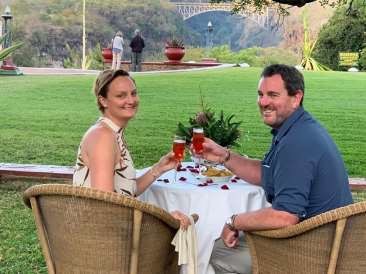

Download printable version here


























